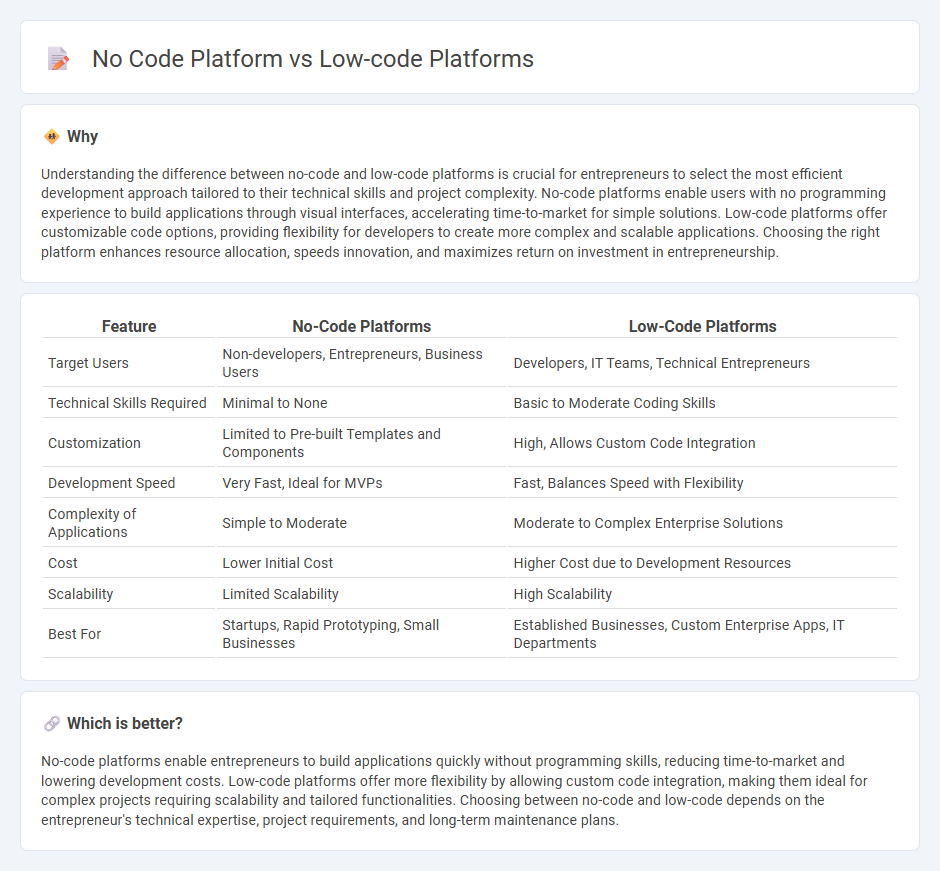
No-code platforms enable entrepreneurs to build applications without any programming knowledge by using visual interfaces, accelerating product development and reducing costs. Low-code platforms offer more customization and integration capabilities by allowing developers to add code, balancing speed with flexibility. Explore how choosing between no-code and low-code solutions can impact your business growth and innovation strategies.
Why it is important
Understanding the difference between no-code and low-code platforms is crucial for entrepreneurs to select the most efficient development approach tailored to their technical skills and project complexity. No-code platforms enable users with no programming experience to build applications through visual interfaces, accelerating time-to-market for simple solutions. Low-code platforms offer customizable code options, providing flexibility for developers to create more complex and scalable applications. Choosing the right platform enhances resource allocation, speeds innovation, and maximizes return on investment in entrepreneurship.
Comparison Table
| Feature | No-Code Platforms | Low-Code Platforms |
|---|---|---|
| Target Users | Non-developers, Entrepreneurs, Business Users | Developers, IT Teams, Technical Entrepreneurs |
| Technical Skills Required | Minimal to None | Basic to Moderate Coding Skills |
| Customization | Limited to Pre-built Templates and Components | High, Allows Custom Code Integration |
| Development Speed | Very Fast, Ideal for MVPs | Fast, Balances Speed with Flexibility |
| Complexity of Applications | Simple to Moderate | Moderate to Complex Enterprise Solutions |
| Cost | Lower Initial Cost | Higher Cost due to Development Resources |
| Scalability | Limited Scalability | High Scalability |
| Best For | Startups, Rapid Prototyping, Small Businesses | Established Businesses, Custom Enterprise Apps, IT Departments |
Which is better?
No-code platforms enable entrepreneurs to build applications quickly without programming skills, reducing time-to-market and lowering development costs. Low-code platforms offer more flexibility by allowing custom code integration, making them ideal for complex projects requiring scalability and tailored functionalities. Choosing between no-code and low-code depends on the entrepreneur's technical expertise, project requirements, and long-term maintenance plans.
Connection
No-code and low-code platforms accelerate entrepreneurship by enabling rapid application development without extensive coding skills, empowering founders to launch MVPs quickly and validate ideas. These platforms provide intuitive drag-and-drop interfaces and pre-built modules, reducing time-to-market and development costs for startups. Entrepreneurs leverage no-code and low-code tools to streamline operations, automate workflows, and scale business solutions efficiently.
Key Terms
Customization
Low-code platforms offer greater customization by allowing developers to write custom code alongside visual development tools, enabling tailored solutions that meet complex business requirements. No-code platforms prioritize ease of use with pre-built templates and drag-and-drop interfaces, which limit customization but accelerate development for users without coding skills. Explore the differences in customization flexibility to determine the best fit for your project needs.
Technical Skill Requirement
Low-code platforms require users to have basic programming knowledge and some understanding of software development concepts, enabling customization through code when necessary. No-code platforms are designed for non-technical users, offering drag-and-drop tools and pre-built templates to create applications without writing any code. Explore detailed comparisons to find which platform aligns best with your team's technical skills and project needs.
Scalability
Low-code platforms offer greater scalability by enabling developers to customize and extend applications with code, making them suitable for complex, enterprise-level projects. No-code platforms prioritize ease of use and rapid deployment but often face limitations when scaling due to restricted customization options and integration capabilities. Explore the differences in scalability to determine which platform best fits your business growth needs.
Source and External Links
Top 10 Open-Source Low-Code Platforms to Streamline Business Apps - Highlights open-source low-code platforms such as Skyve and Baserow, which enable rapid app development and database management with customizable and collaborative features, suitable for enterprise use.
Enterprise Low-Code Application Platforms - Defines low-code platforms like Joget and Quixy that support visual programming, business process automation, and scalable enterprise-grade app creation with tools accessible to non-coders and developers alike.
Low-Code Development: A Guide for IT Leaders - Describes OutSystems as a leading low-code platform offering rapid, scalable, and customizable app development with AI integration and extensive training resources for both novice and expert developers.
 dowidth.com
dowidth.com